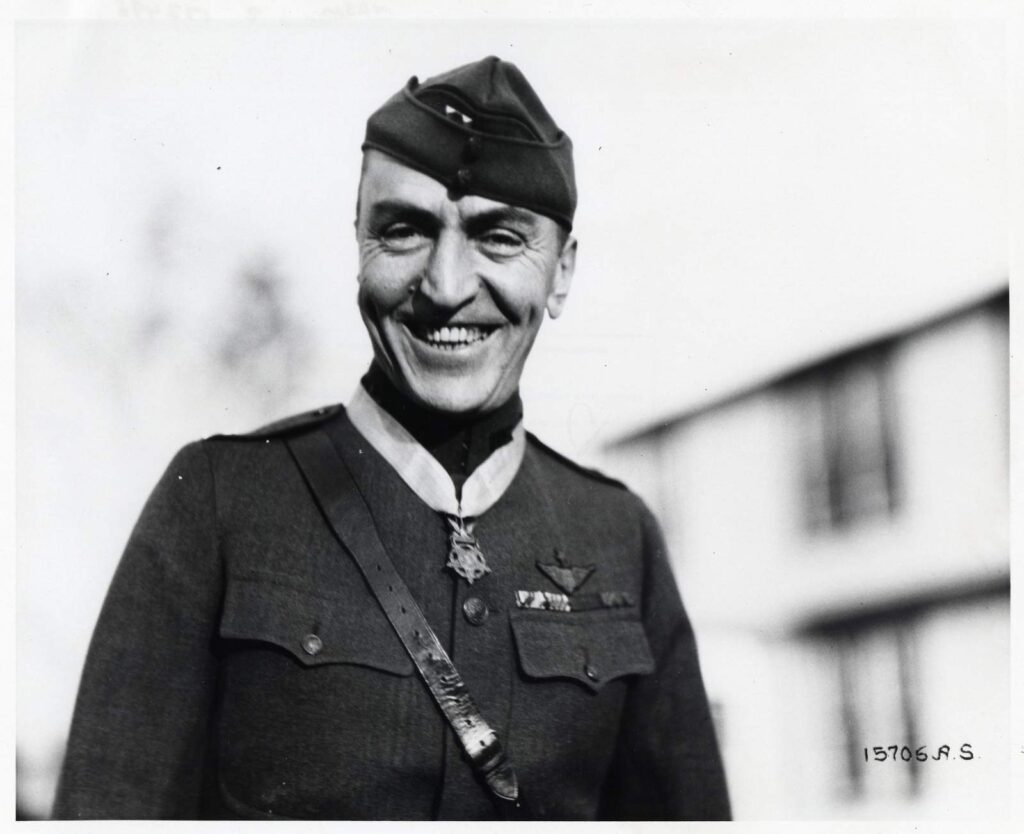
Eddie Rickenbacker (U.S. Air Force photo)
Eddie Rickenbacker, a beloved veteran of the American Legion,[1] first rose to prominence as a race-car driver having appeared in every Indianapolis 500 race before World War I, and as a driver for the factory teams of Peugeot and Maxwell. Rickenbacker wasn’t merely a good driver and pilot. Before his skill at the wheel was recognized, Rickenbacker had studied engineering via a correspondence course. An early internal-combustion enthusiast, he had also worked for the Columbia Buggy Company selling its Firestone-Columbus automobiles. [i]
Rickenbacker made an arrangement with General Motors founder Billy Durant wherein he had the dealership rights to promote the GM Sheridan model car in California. He used San Francisco as a base for his California dealership, because its central location afforded potential access by air to all parts of the state. He got a good deal on the lease of a single-seat Bellanca, and then flew to Bakersfield, Stockton, and other places interviewing dealership applicants.
Among his other American Legion activities, Rickenbacker spent the first eight months of 1921 traveling the Golden State, promoting the Sheridan and opening new dealerships there. When the new Sheridan model car was released, Rickenbacker had 27 dealerships across California and had sold more than 700 cars.[ii]
During this time, Rickenbacker was a member of the American Legion’s Military Affairs Committee under the National Security Commission and made a statement to the National Executive Committee (NEC) of the American Legion at its meeting in Washington, DC on 25 January 1922. The statement, which summed-up the Legion’s position, outlined the following direct quote points:
- “It is positively necessary to create a separate department of aeronautics, and to have a Secretary of Air”
- “If there was a department created for aeronautics, aeronautics would advance far more rapidly and to a much greater advantage.”
- We need “A department for commercial aviation, which after all is the foundation and must be the future of aeronautics in this quarter, as well as a Department of Research.”
- “Without a commercial department for aviation I don’t believe that it is going to be possible for the United States, the army and the navy in time of war to develop or build up an industry.”
- “We must create a demand for the commercial airplane in time of peace, which will build the industry on a solid foundation, which can be converted overnight into a defensive weapon.”
- “In that way in my opinion, we are not only training pilots, but also ground force.”
- “The pilots, in my estimation, who are capable of flying across country for any commercial venture are eighty five to ninety percent war perfect.”
- “A man who can find his way in times of peace and travel on schedule is much more efficient than a man who is trained in time of war, with the haste and hysteria of that goes with it.”
- “Industry ― if they were building planes, could put through with a new design without any great difficulty.”
- “The ships that are used for commercial purposes, after all, with a few alterations are adapted to war use.”
- “There are certain essential fundamentals needed in both cases: the ability to carry a maximum load, ability to maintain a maximum speed over a maximum number of hours.”
- “Then for the research: America gave the airplane to the world. Naturally it is inherent with the American to be interested in the development of that invention.”
- “Carry on with the Research Department. That is so vitally important to aeronautics that the government should have a hand in it – should support it – especially during these years of infancy, when it is badly needed.”
- “Its relationship to the defense of the United States in peace time can also be utilized by creating and developing National Guard air units.”
- “I don’t believe that today there are 1% of the pilots trained by the United States who are able to go out and successfully handle a plane. And yet they would all be very happy and willing to keep up their flying if they just had the opportunity.”
- “Every state in the Union ought to have its own air unit, controlled by the National Guard of that state, or possibly two or three units.”
The NEC directed the National Adjutant, Lemuel Bolles, to send the statement out to every Post. This was done with Memorandum Number 47 which was sent out on 11 April 1922. Right up until war was upon our doorstep in the 1930s the pleas from the American Legion to build our military aviation defense capabilities fell largely on deaf ears in the government. With its membership representing all branches of service, it was one of the few powerful organizations that fully appreciated the dependence of the nation’s security upon the strength distributed among the Army, Navy, Marine Corps, Coast Guard, and the Merchant Marine. Admirals and Generals were inclined to exalt the virtues of their own branch of service and the weapons they used.
By 1946, all of the points that Eddie Rickenbacker outlined and promoted by the American Legion had came to fruition, including an independent Air Force, the National Advisory Committee for Aeronautics (precursor to NASA), Air National Guard units across the country, and the Air Commerce Act was passed in 1926 and the Bureau of Air Commerce (precursor to the FAA) was established in 1934. All of these things came about with the lobbying and support of the American Legion and its Aeronautics Commission.
[1] https://www.legion.org/belovedveterans/220482/eddie-rickenbacker
[i] Conwill, David, “Too Much, Too Soon – 1925 Rickenbacker Vertical Eight Superfine,” Hemmings Classic Car, November 2017.
[ii] Lewis, David, “Eddie Rickenbacker: an American hero in the twentieth century,” Johns Hopkins University Press, Baltimore, MD, December 2005, pages 249-250.












